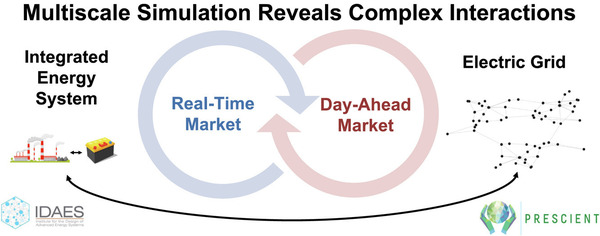
Our paper, Multiscale simulation of integrated energy system and electricity market interactions, has been published in Applied Energy.
You can download the PDF for free until June 2, 2022, using this link: https://authors.elsevier.com/a/1evGE15eif4RqE
Here is the abstract:
Accelerating the deep decarbonization of the world’s electric grids requires the coordination of complex energy systems and infrastructures across timescales from seconds to decades. In this paper, we present a new multiscale simulation framework that integrates process- and grid-centric modeling paradigms to better design, operate, and control integrated energy systems (IESs), which combine multiple technologies, in wholesale energy markets. Traditionally, IESs are analyzed with a process-centric paradigm such as levelized cost of electricity (LCOE) or annualized net revenue, ignoring important interactions with electricity markets. This framework explicitly models the complex interactions between an IES’s bidding, scheduling, and control decisions and the energy market’s clearing and settlement processes, while incorporating operational uncertainties. Through two case studies, we show the importance of understanding and quantifying complex resource-grid interactions. In case study 1, we demonstrate that optimized bidding from one resource shifts the profit distribution for all energy systems in the market. This result suggests new and more flexible IES technologies can disrupt the economics of all market participants, possibly leading to accelerated retirements of less flexible resources. Interestingly, the optimized bidding has little impact on grid-level aggregate statistics, such as total generation costs and renewable penetration rate. While aggregate modeling strategies may remain valid under some IES adoption scenarios for analysis focused on regional outcomes, direct comparisons of IES technologies at specific locations without considering these interactions may lead to misleading or incorrect conclusions. In case study 2, we consider the design and flexible operation of IESs that hybridize conventional generators with energy storage. Through a sensitivity analysis, we find that as the size of the storage system increases, the total number of start-ups for coal- and natural gas-based IESs reduced by 25% and 33.6%, and the total thermal generator ramping (i.e., mileage) reduced by 86.5% and 62.5%, respectively. This shows the primary benefit of storage may not be reduced operational costs (which do not change significantly) but fewer start-ups and less ramping, which may greatly simplify the design, operation, and control of carbon capture systems. The new modeling and optimization capabilities from this work enable the coupling of rigorous, dynamic process models with grid-level production cost models to quantitatively identify the nuanced interdependencies across these vast timescales that must be addressed to realize clean, safe, and secure energy production. Moreover, the proposed general multiscale simulation framework is applicable to all IES technologies and can be easily extended to consider other energy carriers (e.g., hydrogen, ammonia) and energy infrastructures (e.g., natural gas pipelines).